12 Types Of Bananas And How To Use Them
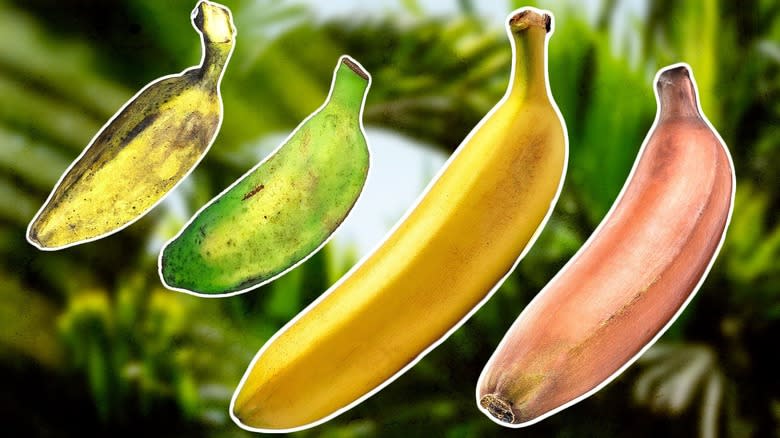
Bananas are the most consumed fruit in the world, but for such a popular and widespread product, we know surprisingly little about them. For starters, many don't know that bananas are classified as berries, and that's why they'll sometimes ooze a faint berry-like aroma. To be fair, we are aware that bananas are perhaps the most convenient and portable fruit that is always good to have on hand, and we'll continue to praise them for their health benefits and potassium levels. Most of all, we openly love bananas due to the instant boost of energy they can provide. Where we generally fail is when it comes to banana varieties and their culinary potential.
Though there are over 1000 banana varieties worldwide, and we consume over 100 billion bananas every year, 99% of the banana market is reserved for the Cavendish variety. Though Cavendish is pleasant and tasty, we are missing out on all other varieties that often differ in texture, flavor, aroma, and the way you can use them. To at least partially fix this banana injustice, we bring you some of the most popular and interesting bananas around the world and advise you on how to use them. Though most bananas call for a warm, tropical climate, you won't see many of them being cultivated in the U.S., but it's now easier than ever to order a batch and get it delivered. Hopefully, you'll use this article as inspiration.
Read more: 7 Nuts You Should Be Eating And 7 You Shouldn't
Cavendish Is The Most Widespread Variety That You Should Fry, Add To Smoothies, Or Use In Banana Bread

Cavendish is the most widespread banana variety and the one you'll find at your local store. It became dominant in the 1950s after the infamous Panama disease destroyed most crops of Gros Michel, a variety that was initially superior in flavor and quality. Cavendish proved to be a suitable replacement as it was resistant to diseases and could store well and slowly ripen, which was ideal for export.
There's a reason why Cavendish is the most popular variety these days. Besides being resilient, it is also a great all-rounder, suitable for various uses, depending on the ripeness stage. Green and underripe Cavendish is not best for desserts. The firm flesh and very subtle sweetness can perhaps only work for savory recipes or anything that entails cooking. The second stage is when the banana is still not fully ripe, though sweetness will be more prominent than in the initial stage. This banana is ideal for desserts that involve frying, such as the classic banana Foster. Fully ripe Cavendish has yellow skin and yellow flesh with ample sweetness. This version is great for puddings and cakes where you want to retain some structure or for blending into smoothies. Lastly, the very ripe and overripe Cavendish, easily recognized for its dark brown spots, is at the ideal ripening stage for banana bread, muffins, pancakes, and waffles.
Blue Banana Is The Got-To Option For All Types Of Desserts
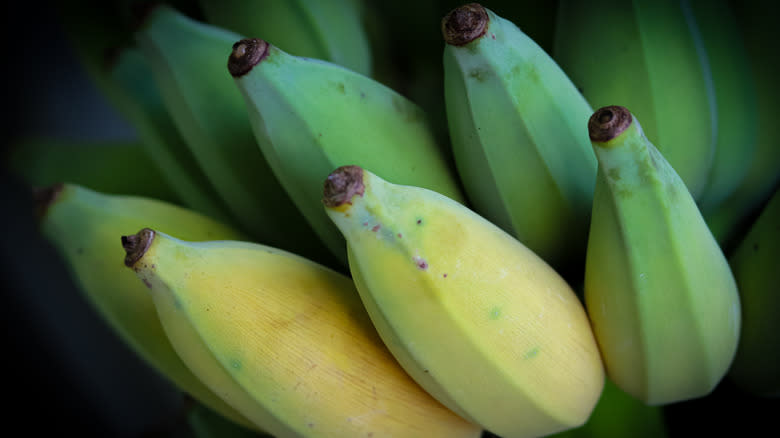
You'll find the blue banana labeled as Java or ice cream banana. The moniker blue is due to the faint blue tint of its skin when the banana is not fully ripe, while the name ice cream banana reflects the texture that many compare to ice cream.
Blue bananas are native to Southeast Asia, but they are now grown in other parts of the world, though they remain relatively rare and generally are not easy to find. When fully ripe, they have bright yellow skin and very dense, creamy flesh that is medium sweet, subtly tart, and could potentially remind you of ice cream. This short and chubby banana ripens quickly and can't survive long following the harvest.
Blue bananas are great on their own, but you can also incorporate them into various desserts. As the flesh is compact, you can cook with them, but a mashed version would work well in all types of cakes and sweet bakes. The easiest way to get the most out of this banana is to peel it and freeze the flesh. The frozen version can go into smoothies, but you can also have it plain, preferably mashed to make something like a banana slushie or an ice cream dessert.
Latundan Bananas Are The Perfect Dessert Bananas With A Sweet Flavor And Creamy Texture
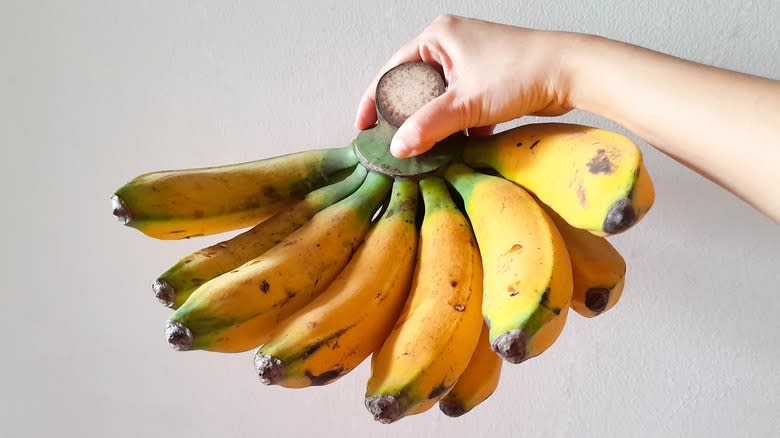
Latundan bananas are cultivated in the Philippines, where they are one of the most popular varieties. This is a short banana with a barely noticeable curve and thin skin that turns yellow as the banana ripens. Latundan is sometimes classified as an apple banana, a colloquial term that encompasses several varieties that share similar qualities and grow in Southeast Asia, Hawaii, Florida, and Central and South America. Latundan is loved for its firm white flesh, but it has a light and airy texture that creates a wonderfully creamy mouthfeel. The flavor is sweet and has a pleasant tangy note.
There are multiple ways to use Latundan bananas. They are great on their own as a sweet snack or a dessert, and you can add them to oatmeal and puddings or blend them into creamy smoothies and shakes. This banana is also suitable for pancakes and various sweet bakes. It can also be used instead of Saba bananas for various traditional desserts.
Red Bananas Are Versatile And Work In Savory And Sweet Recipes
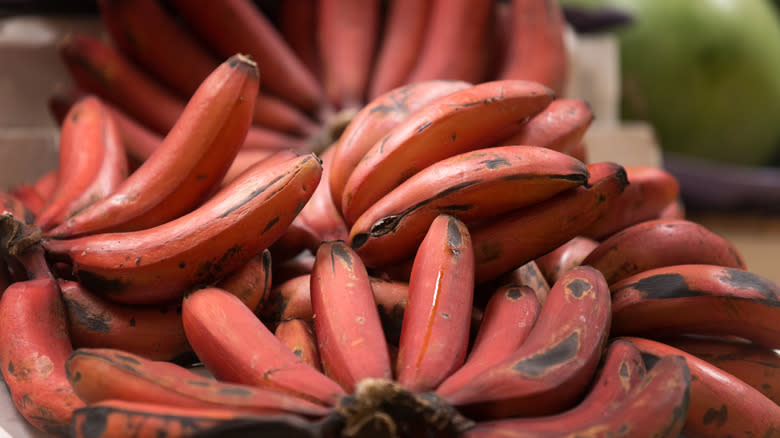
Red banana is a name used for a group of bananas whose skin attains a distinctive brick-red hue. They probably originated in India but are now grown in many Asian and Central American countries. When compared to Cavendish, the red banana has a similar distinctive curve but is typically smaller and shorter. These bananas attain a red color as they ripen and can also develop brown spots when fully ripe. Their skin is thick, while the color intensity and shade vary depending on several factors. The flesh is pale yellow, sometimes with a light pink hue. When fully ripe, this banana is sweet and creamy, with a pleasant fruity aroma. It is ideal for immediate consumption, but its unique characteristics make it suitable for desserts and even savory dishes.
Red bananas can be sliced and served on top of smoothie or yogurt bowls, and you can also incorporate them into creamy smoothies and shakes or turn them into ice cream. They are also good for making muffins and other types of baked cakes and breads. Despite the creamy mouthfeel, this banana has a firm flesh suitable for frying, so you can even caramelize it in the pan or make deep-fried banana chips. In savory versions, it's usually added to curries to add much-needed sweetness and help with the texture.
Lady Finger Bananas Are Packed With Sweetness, So Try Them In Smoothies, Puddings, And Pies
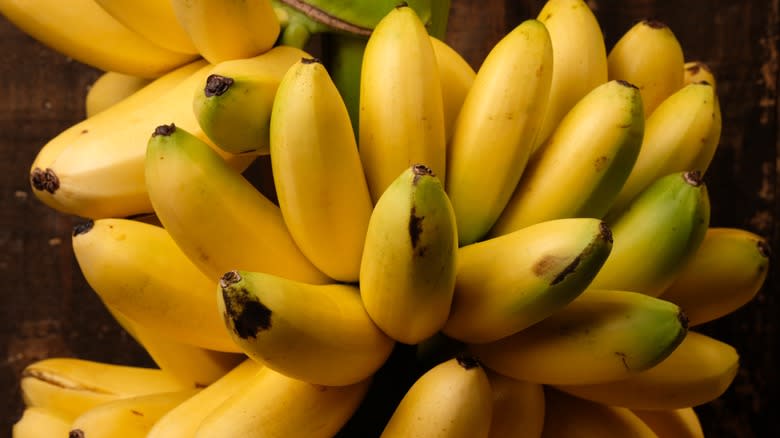
Lady finger bananas is another broader name for several cultivars with similar characteristics. These are smaller bananas with a barely noticeable curve that are covered in thin yellow skin that tends to develop brown specks as the bananas ripen. It's assumed that their origin is in Southeast Asia, but they are now grown in other tropical regions, and are one of the most popular varieties in Australia.
Lady finger bananas have pale flesh with seeds dispersed through the center of the fruit. This banana is firm, but when you bite into it, it reveals its smooth texture. In many ways similar to Cavendish, while the flavor is noticeably sweeter with somewhat of a honey-like quality. Because of this, these bananas are ideal for various desserts. Blend them into smoothies, creams or custards, ice creams, and sorbets, or add them to your favorite banana pie. They would also work in banana bread, waffles, or pancakes. Of course, this is the banana that shines in its raw form, so you can always have it as a snack or use it on top of oatmeal, yogurt, or smoothie bowls.
Burro Bananas Are Firm And Have A Tangy Kick That Works In Savory And Sweet Recipes
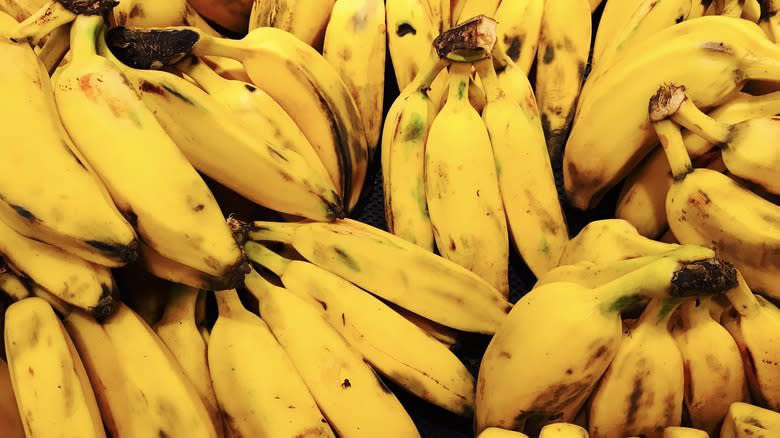
Burro bananas are native to Mexico. They are best distinguished for their distinctive semi-flattened shape, almost resembling an uneven triangle in the cross-section. Though they are smaller than a regular Cavendish, these bananas are not the smallest on the market. They start as underripe green bananas and attain a bright yellow color when fully ripe. The flesh of Burro bananas is pale, dense, and firm, which is ideal for cooking. The flavor is subtly sweet and complemented by a mild citrusy note.
As this is not such a sweet banana, it is often used for savory recipes, but it also works as your classic dessert banana. In both cases, it's best to use it for cooking and baking, as firm flesh is amazing at holding shape. When ripe, this is the banana you want to roast, bake, or grill and then serve warm, preferably sweetened with brown sugar or doused in caramel, and elevated with warming spices. You can also eat it raw or use it for banana bread and other sweet bakes, but they are also amazing fried. When they are not fully ripe, burro bananas are best suited for savory recipes and can be used instead of plantains.
Matoke Are Green Bananas Mostly Used To Make Traditional Savory Side Dish
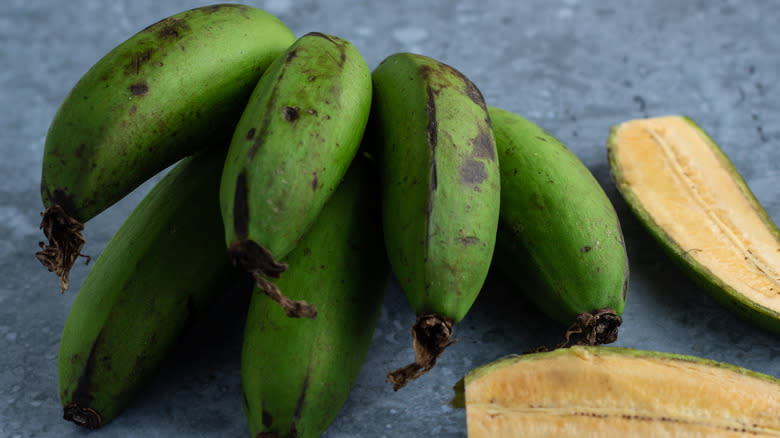
Matoke is a banana variety native to Uganda that is sometimes also called East African Highland banana. The consumption is mostly local and mainly limited to traditional savory recipes. These bananas are typically harvested young, so you can easily recognize them by their short, chunky shape and vibrant green color. The green skin protects tough, starchy flesh that is unpalatable and not consumed raw, so they always call for cooking before they can be eaten.
In Uganda, bananas are a staple and are classified not only as fruit but as a nutritious and nourishing food that can be turned into sweet or savory dishes. Traditionally, bananas are peeled and wrapped in banana leaves to make large pouches that are steamed or boiled until they soften up. Usually, they are turned into a creamy mash that can be eaten as is or served topped with meat-based stews or a peanut sauce. They are also one of the main ingredients in katogo stew, which is a classic representative of traditional Ugandan cuisine. Matoke bananas can also be fried to make crunchy banana chips, and when cooked, they can also be eaten as a dessert, though this is less common.
Saba Bananas Can Go Into Sweet Or Savory Dishes, And Are Also Used To Make Banana Ketchup
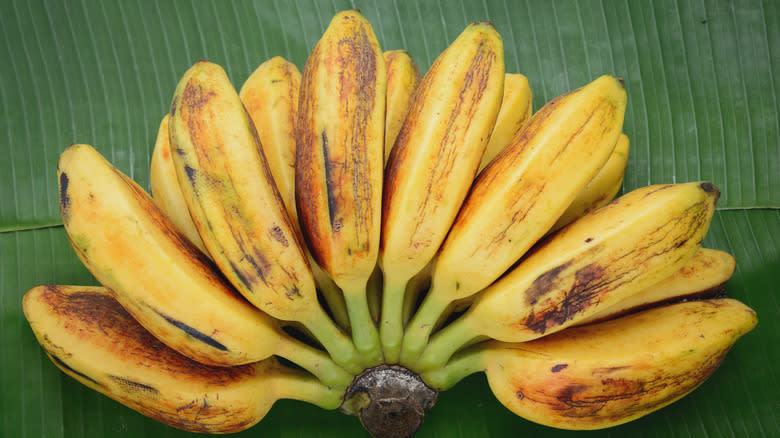
Saba bananas are the most popular banana variety in the Philippines. This is the classic dessert banana that can be eaten raw but performs best when cooked. Saba bananas are thick and chubby with a distinctive green skin that turns yellow as the fruit ripens. You can easily recognize them for their sharp edges and light curves. The whitish flesh is firmer than you'd expect in a typical dessert banana, but it is still relatively soft and creamy. With cooking, it will become sweeter and more tender.
The classic way to use these bananas is to turn them into sweet fritters that are locally known as maruya. They are also commonly used to make turon or lumpia, the Filipino specialty in which banana is wrapped in dough and fried until golden and crispy. Sautéing the bananas in sugary caramel-like sauce is another local favorite. In savory versions, you'll see these bananas inside pochero or bulalo stews.
Saba bananas are also used to make banana ketchup, another Filipino staple that looks like ketchup, but it's nothing like the American version. It uses bananas as the base, along with sugar, spices, and tomato paste or red dye, to make a thick and sticky sauce that is much sweeter than its American counterpart. Banana ketchup is an essential element in the Philippines and can be used as a condiment, marinade, or sauce.
In Polynesia, Fe'i Bananas Are Staple Ingredient That Is Best Suited For Cooking And Roasting
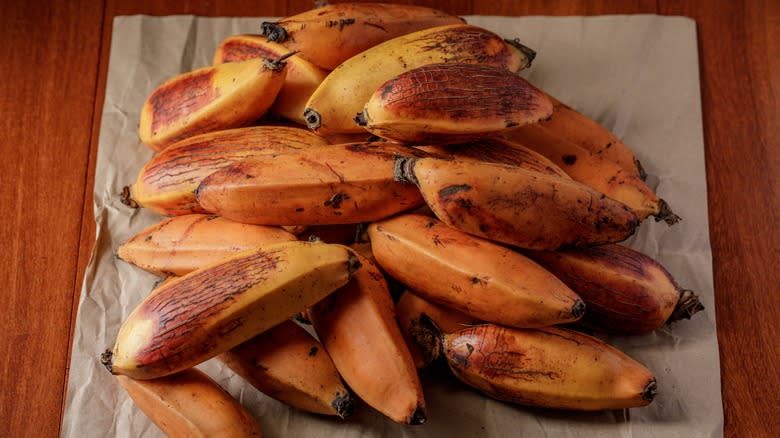
Fe'i bananas are a unique variety mostly cultivated in Hawaii and several islands in the South Pacific. This short and chunky variety is best distinguished by its thick skin, which attains a mix of red and orange hues and is typically covered in visible dark blemishes. When peeled, these bananas showcase beautiful yellowish flesh that is firm, dense, and quite starchy, even when perfectly ripe. This is why Fe'i bananas are usually cooked before they are consumed.
With cooking, bananas become slightly sweeter and more tender, but can still hold their shape well and retain some of their signature tangy flavor. They are usually boiled or roasted and can be served as a side with meat or fish dishes, but they also incorporate well into stews and curries. In sweet versions, you'll often see them partnered with coconut and vanilla.
Goldfinger Bananas Are The Perfect Topping For Oatmeal And Smoothie Bowls
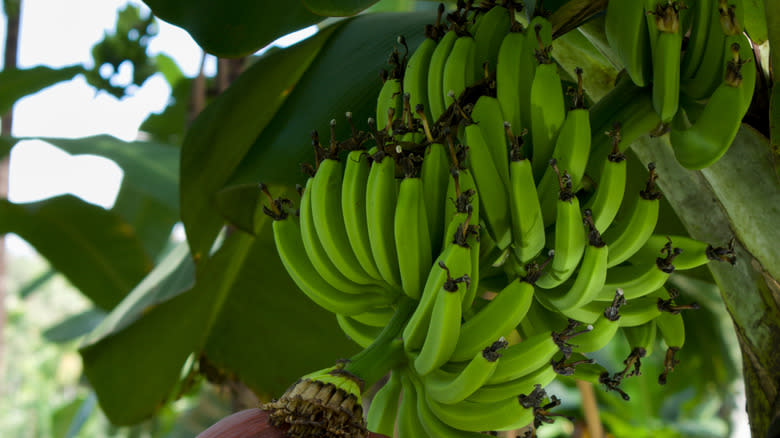
Goldfinger banana is a hybrid variety developed in Honduras. The main goal was to make a resistant variety that would be easy to harvest and still taste good. Goldfinger is a medium-sized banana, shorter than the classic Cavendish, with much sharper edges. The green, unripe variety can be cooked, while the fully ripe, vibrant yellow version can be eaten raw. The flesh is creamy and dense, often compared with the Cavendish variety, but usually slightly softer. The flavor is sweet and subtly tangy, but remains subtle and not overpowering.
Goldfinger is the ideal snacking banana that you can use to top cereals, oatmeal, or yogurt bowls, but there are various other ways to use it in the kitchen. Similar to a Cavendish, this could be a great all-rounder, perfect for raw use in smoothies, ice cream, or custards. When fully ripe, it can be used for baked desserts, but as it stays relatively firm after cooking, it could also be suitable for pan-frying and sautéing. Unlike Cavendish, this banana does not oxidize quickly, so it could be the potentially superior option for fruit salads and cakes where it's used raw.
Pisang Tanduk Is An Indonesian Plantain You Should Be Cooking

Pisang tanduk is a plantain variety native to Indonesia that is mainly used for cooking. This is a large, curved variety covered in a thick green skin that will turn yellow as the plantain ripens, and it's easily distinguished for its size and signature pointy tips. Though it is used at ripe stages, it's not suitable for raw consumption. Pisang tanduk has a firm and dense flesh that will completely transform with cooking, attaining smooth, creamy texture. As the plantain ripens, it will develop sweetness, which will additionally enhance with cooking. This is a variety you can steam, fry, grill, or roast, depending on how you want to use it.
Pisang tanduk is traditionally used to make popular fritters locally known as pisang goreng. This dish best works with ripe fruit as the slices are dipped in tempura-like batter and are then shortly fried until golden and crisp. This classic comes in numerous regional varieties, and in Indonesia, it's a traditional afternoon treat best enjoyed with tea or coffee. Pisang tanduk is also sometimes cooked with sugar and coconut milk to make a soupy pengat pisang. Steamed versions can be eaten plain, partnered with syrups or sugar, or added to various curries and stews.
Mysore Bananas Are Sweet And Ideal For Desserts

Mysore bananas are native to India and Pakistan and are named after the Mysuru city in Karnataka. They belong to the short and chunky group and can be classified as a typical dessert banana. Mysore have a relatively thin skin that goes from bright green to bright yellow as the fruit ripens. Underneath the skin, this banana packs firm, whitish flesh that has some bite, but comes off as smooth and silky when you bite into it. The flavor comes through as sweet but has a zesty, subtly sour kick to it.
Because of their characteristics, these bananas can be consumed raw or cooked and are suitable for savory dishes, but truly shine in sweets and desserts. They make a great snack but also work as a topping for oats and yogurt bowls, or on top of toast and inside fruit salads. You can also add them to smoothies or freeze and blend them into a slushie-like mix. These bananas are incorporated in several traditional desserts but can also be used in banana bread or similar baked treats. They are also used to make a local version of fried bread that is usually served with chutney or curry.
Read the original article on Mashed


